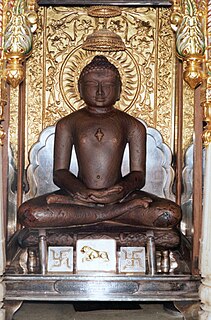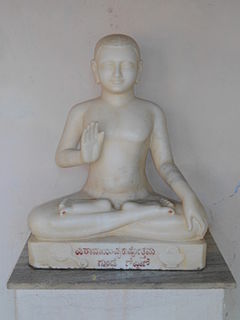
Jainism, traditionally known as Jain Dharma, is an ancient Indian religion. Followers of Jainism are called "Jains", a word derived from the Sanskrit word jina, meaning "victor". Jains trace their spiritual ideas and history through a succession of twenty-four leaders or tirthankaras, with the first being Rishabhanatha, who according to Jain tradition lived millions of years ago, the twenty-third tirthankara Parshvanatha in 900 BCE, and the twenty-fourth tirthankara the Mahāvīra around 500 BCE. Jains believe that Jainism is an eternal dharma with the tirthankaras guiding every cycle of the Jain cosmology. Their canonical religious texts are called Agamas and Paramagamas.

Mahavira, also known as Vardhamana was the 24th tirthankara of Jainism. He was the spiritual successor of 23rd tirthankara Parshvanatha. Mahavira was born in the early part of the 6th century BCE into a royal Kshatriya Jain family in present-day Bihar, India. His mother's name was Trishala. He abandoned all worldly possessions at the age of about 30 and left home in pursuit of spiritual awakening, becoming an ascetic. Mahavira practiced intense meditation and severe austerities for 12 and half years, after which he attained Kevala Jnana (omniscience). He preached for 30 years and attained moksha (salvation) in the 6th century BC, although the year varies by sect.

The Śvētāmbara is one of the two main branches of Jainism, the other being the Digambara. Śvētāmbara means "white-clad", and refers to its ascetics' practice of wearing white clothes, which sets it apart from the Digambara "sky-clad" Jains, whose ascetic practitioners go naked. Śvētāmbaras, unlike Digambaras, do not believe that ascetics must practice nudity.

Parshvanatha, also known as Parshva and Paras, was the 23rd of 24 tirthankaras of Jainism. He is one of the earliest tirthankaras who are acknowledged as historical figures. He was the earliest exponent of Karma philosophy in recorded history. The Jain sources place him between the 9th and 8th centuries BC whereas historians point out that he lived in the 8th or 7th century BC. Parshvanatha was born 273 years before Mahavira. He was the spiritual successor of 22nd tirthankara Neminath. He is popularly seen as a propagator and reviver of Jainism. Parshvanatha attained moksha on Mount Sammeta in the Ganges basin, an important Jain pilgrimage site. His iconography is notable for the serpent hood over his head, and his worship often includes Dharanendra and Padmavati.

Ācārya Bhadrabāhu was, according to the Digambara sect of Jainism, the last Shruta Kevalin in Jainism but Śvētāmbara, believes the last Shruta Kevalin was Acharya Sthulabhadra, but was forbade by Bhadrabahu from disclosing it. He was the last acharya of the undivided Jain sangha. He was the spiritual teacher of Chandragupta Maurya, the founder of Maurya Empire.

Kundakunda was a Digambara Jain monk and philosopher, who likely lived in the 2nd CE century CE or later.

Jain monasticism refers to the order of monks and nuns in the Jain community. The term nirgrantha ("bondless") was used for Jain monks in the past. The monastic practices of two major sects vary greatly, but the major principles of both are identical. Five mahāvratas, from Mahavira's teachings, are followed by all Jain ascetics. Historians believe that a united Jain sangha (community) existed before 367 BCE, about 160 years after the moksha (liberation) of Mahavira. The community then gradually divided into two denominations: the Digambara and the Śvētāmbara.

Neminatha is the twenty-second tirthankara (ford-maker) in Jainism. He is also known simply as Nemi, or as Aristanemi which is an epithet of the sun-chariot. Along with Mahavira, Parshvanatha and Rishabhanatha, Neminatha is one of the twenty four tirthankaras who attract the most devotional worship among the Jains.

Sudharmaswami was the fifth ganadhara of Mahavira. All the current Jain acharyas and monks follow his rule.

Siddhasēna Divākara was a jain monk in the fifth century CE who wrote works on Jain philosophy and epistemology. He was like the illuminating lamp of the Jain order and therefore came to be known as Divākara "Lamp-Maker". He is credited with the authorship of many books, most of which are not available. Sanmatitarka is the first major Jain work on logic written in Sanskrit.

In Jainism, the term Ganadhara is used to refer the chief disciple of a Tirthankara. In samavasarana, the Tīrthankara sat on a throne without touching it. Around, the Tīrthankara sits the Ganadharas. According to Digambara tradition, only a disciple of exceptional brilliance and accomplishment (riddhi) is able to fully assimilate, without doubt, delusion, or misapprehension, the anekanta teachings of a Tirthankara. The presence of such a disciple is mandatory in the samavasarana before Tirthankara delivers his sermons. Ganadhara interpret and mediate to other people the divine sound (divyadhwani) which the Jains claim emanates from Tirthankara's body when he preaches.
Jainism is a religion founded in ancient India. Jains trace their history through twenty-four tirthankara and revere Rishabhanatha as the first tirthankara. Some artifacts found in the Indus Valley civilization have been suggested as a link to ancient Jain culture, but this is highly speculative and a subjective interpretation. This theory has not been accepted by most scholars because very little is known about the Indus Valley iconography and script. The last two tirthankara, the 23rd tirthankara Parshvanatha and the 24th tirthankara Mahavira are considered historical figures. Mahavira was a contemporary of the Buddha. According to Jain texts, the 22nd Tirthankara Neminatha lived about 85,000 years ago and was the cousin of Hindu god Krishna. Jains consider their religion eternal.
A Pattavali, Sthaviravali or Theravali, is a record of a spiritual lineage of heads of monastic orders. They are thus spiritual genealogies. It is generally presumed that two successive names are teacher and pupil. The term is applicable for all Indian religions, but is generally used for Jain monastic orders.

Kevala jñāna or Keval gyāna means omniscience in Jainism and is roughly translated as complete understanding or supreme wisdom.

Jain literature comprises Jain Agamas and subsequent commentaries on them by various Jain ascetics. Jain literature is primarily divided between Digambara literature and Śvētāmbara literature. Jain literature exists mainly in Magadhi Prakrit, Sanskrit, Marathi, Tamil, Rajasthani, Dhundari, Marwari, Hindi, Gujarati, Kannada, Malayalam, Tulu and more recently in English.

Digambara is one of the two major schools of Jainism, the other being Śvētāmbara (white-clad). The Sanskrit word Digambara means "sky-clad", referring to their traditional monastic practice of neither possessing nor wearing any clothes.

Jainism is an Indian religion which is traditionally believed to be propagated by twenty-four spiritual teachers known as tirthankara. Broadly, Jainism is divided into two major schools of thought, Digambara and Svetambara. These are further divided into different sub-sects and traditions. While there are differences in practices, the core philosophy and main principles of each sect is same.

Bharata is claimed to be the first chakravartin of avasarpini in Jain tradition. He was the eldest son of Rishabhanatha, the first tirthankara of Jainism. According to the Jains, the ancient name of India was named "Bhāratavarsha" or "Bhārata" or "Bharata-bhumi" after him. He had two sons from his chief-queen Subhadra named Arkakirti and Marichi. He is said to have conquered all the six parts of the world and to have engaged in a fight with Bahubali, his brother, to conquer the last remaining city.
Jinabhadra or Vachanacharya Jinabhadragani Kshamakshmana was Jain ascetic author of Prakrit and Sanskrit texts.

Jambuswami was the spiritual successor of Sudharmaswami in Jain religious order reorganised by Mahavira. He remained the head for 39 or 44 years, after which he is believed to have gained Kevala Jnana (omniscience). He is believed to be the third and last kevali after Mahavira in Jain tradition. He is believed to have attained moksha (liberated) at the age of 80 in Mathura.
















